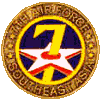| |
|
|
|
Joseph Andrew Matejov
Sergeant
6994TH SEC SQDN, 7TH AF United States Air Force East Meadow, New York February 02, 1952 to February 05, 1973 JOSEPH A MATEJOV is on the Wall at Panel W1, Line 115 See the full profile or name rubbing for Joseph Matejov |
  |
  |
|
To Joseph A. Matejov and his family I've worn your bracelet proudly for the last 16 years. The sacrifice you made will NEVER be forgotten. YOU will never be forgotten. I think of you daily and wonder. May God bless you and hold you near.
I would like to hear from anyone who knew
Linda Orzel |
|
To family and friends and veterans alike: I am John G Hatem, MSGT, USAF (Ret), and I was in South East Asia at the time of Sgt Matejov's being shot down. About 11 years ago I retired to Maryland and took my older brother to The Wall and we were looking for bracelets from our NY area - Westbury (W T Clarke HS) or East Meadow (where my brother had gone for a while). I saw none from Clarke, but found Sgt Matejov's and have worn it every day since then. I have been asked why I still wear it and say "He and they are still there". A friend from high school, Army PFC Thomas P Jackson, was killed in action, and I never found his bracelet, but I have a printout of him also on my dresser, each man having their own statute of the 3 Soldiers for their own. To all my love and prayers. A Vet who remembers and always will.
From a USAF Viet Nam Vet and bracelet holder, |
|
Dear Joe,
-Sarah Alexander |
|
For 15 years
I am grateful
May his name
Sarah Kuglin |
|
Joe, I was with USAFSS/ESC from 1975-85, NSA from 75-80 and the 6924th ESS from 81-85. I've worn your bracelet since before 1990, it's now 2004. While at NSA I worked with Terry M. and Jerry M. on the SEA problem. Come home soon.
John Aquaro III |
|
I went to a local fair in the summer of 1990 and came across a booth run by a couple of Vietnam veterans. I had just signed up for the U. S. Air Force delayed enlistment program. I stopped to look, and talk to the men. The majority of the booth space was comprised of MIA/POW braclets. The red aluminum bracelet I was wearing was very close to breaking so I looked through the ones for an enlisted person close to where I was from (Binghamton, NY) and that was when I first saw the name Joseph A. Matejov. Other than when I was at work and unable to wear it I always have it on and think of Joseph all the time. When I attended Airman Leadership School in 1998 I was required to give a speech. The Instructor suggested it be about something important to us. I spoke about Joseph and expanded to the overall topic of all POW/MIA personnel. I have worn this braclet for almost 14 years and it is starting to crack. I am trying to find a way to buy a new one and would really like to send this one to the Matejov family.
Jason E. Robinson |
|
My brother Michael Arciola was killed in Iraq last year. I wear a bracelet in his honor. While in Washington recently, to visit Michael at Arlington, I went to the Wall. I knew about the bracelets that were sold there and felt the need to have one. Michael and Joseph will always be with me. I think of them every time I hear the clink of the bracelets. To Joseph's family: Know that you are not alone.
Casey Arciola
From The Virtual Wall: |
|
My wife has come across Sgt Matejov's bracelet at her work. She works at a hotel in Savannah, Georgia, and states that this bracelet has been there for over a year. We would love to return it to its rightful owner as I am sure they miss it. It you have any info about this please contact me.
From |
Notes from The Virtual WallOn February 5, 1973, about a week after the signing of the Paris Peace Agreement, an EC-47Q electronic warfare collection aircraft (tail number 43-48636) was shot down over Saravane Province, Laos, about 50 miles east of the city of Saravane. The aircraft belonged to and was crewed by the 361st Tactical Electronic Warfare Squadron, but the collection crew "back-enders" were from the 6994th Security Squadron:
From the POWNetwork.org report: "Over five years later, Joe Matejov's mother, Mary Matejov, heard columnist Jack Anderson, on "Good Morning America", describe a Pathet Lao radio communique which described the capture of four "air pirates" on the same day as the EC-47Q carrying her son was shot down. No other plane was missing that day. Anderson's information indicated that reconnaissance personnel had 40 uninterrupted minutes in which to survey the crash site.Hobson, in "Vietnam Air Losses", puts a slightly different slant on matters. He writes that the wreckage was located on 07 Feb and three US Air Force rescuemen were lowered to the crash site on 09 Feb 73. The rescuemen sighted at least four bodies but were able to recover the partial remains of only one airman (Bernhardt). The rescuemen could not remain on the ground long enough to extract and hoist the remains of the others to the hovering helicopter overhead. Hobson states that a joint Lao-US team excavated the site in 1993, recovering human remains and eight parachute "D" rings, one for each of the eight parachutes taken aboard the C-47. Although individual remains could not be identified, it was clear that none of the eight crewmen had parachuted to safety and there was no physical evidence indicating that any had survived the crash and post-crash fires. While the family members of some crewmen refused to accept the DoD finding that all eight men had died in the crash, the comingled remains of these men were given a group burial in December 1995. |
A PROMISE TO NEVER FORGET
Monday, May 27, 2002 |
| Contact Us | © Copyright 1997-2019 www.VirtualWall.org, Ltd ®(TM) | Last update 08/15/2019. |